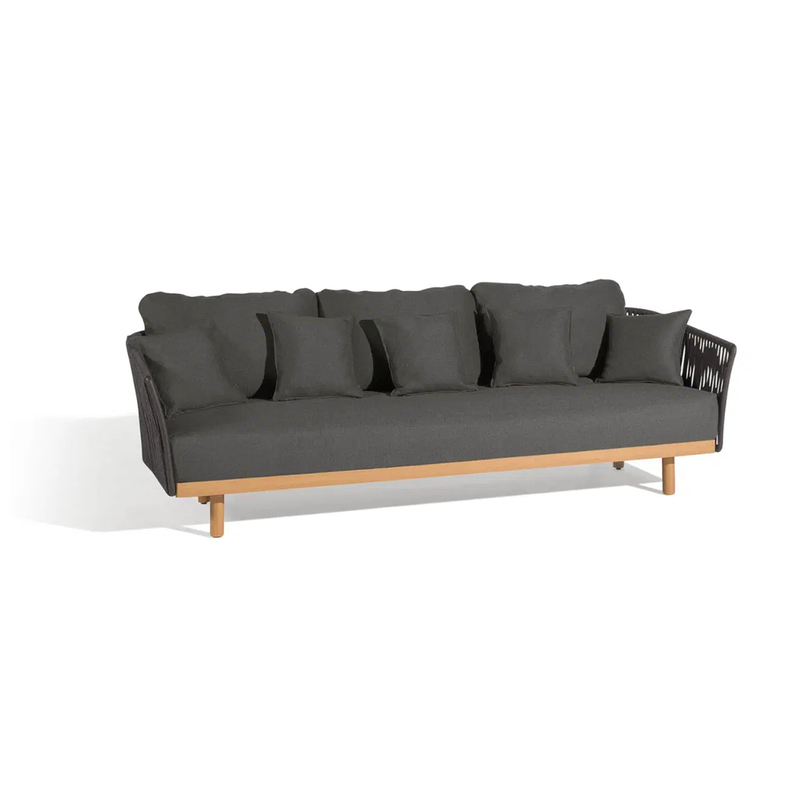Faux leather sofas are a stylish, affordable alternative to genuine leather. They’re gaining popularity for their durability and modern look.
Proper cleaning and maintenance are essential to keep them looking new. Faux leather is resistant to stains and scratches, making it a great choice for busy households.
In this post, we’ll discuss how to clean and care for your faux leather sofa to ensure it lasts for years.

Faux leather is a synthetic material made to resemble real leather. It’s typically made from PVC (Polyvinyl Chloride) or PU (Polyurethane). These materials mimic the texture and look of genuine leather while being more affordable.
While genuine leather is made from animal hides, faux leather is entirely man-made. This gives it a more uniform appearance, often with a smoother texture. Faux leather is also lighter and more flexible than real leather. However, it doesn’t have the same natural feel and aging process as genuine leather, which develops unique patinas over time.
Faux leather offers several benefits. First, it’s budget-friendly. A faux leather sofa costs much less than a real leather one. Plus, it’s easy to clean and maintain, needing only occasional wiping to stay in good shape.
Another advantage is its eco-friendliness. Faux leather is a sustainable option compared to animal leather. It's a cruelty-free alternative that doesn’t involve the use of animals, making it an ethical choice for many consumers.
Faux leather sofas are also highly popular in modern interior design. They come in a variety of styles and colors, fitting into nearly any home decor. Whether you prefer a sleek, modern look or a classic, warm vibe, there’s a faux leather sofa for you.
Regular cleaning is key to keeping your faux leather sofa looking its best. Dirt and dust can accumulate over time, leading to stains or damage if not cleaned properly.
For light cleaning, dust your sofa weekly to avoid buildup. A more thorough cleaning should be done once a month to keep it fresh and free from grime.
When cleaning faux leather, it's important to use the right tools to avoid damage. Here are the best options:
● Soft-bristle brushes: Gently sweep away dust from seams and crevices.
● Microfiber cloths: Ideal for wiping down the surface without leaving scratches.
● Vacuum cleaners with upholstery attachments: Perfect for removing dirt from hard-to-reach areas.
Avoid using rough sponges or brushes, as they may scratch the surface or cause wear over time.
While household cleaners may seem convenient, not all are safe for faux leather. Here's what to know:
● Do's: Use a mild soap solution with water to clean. Specialized faux leather cleaners are also safe.
● Don’ts: Avoid cleaners with harsh chemicals like bleach, ammonia, or solvents, as they can cause cracking and discoloration.
Always test a small, hidden area first to ensure the cleaner doesn't harm the surface.
Start by removing dust and debris from your faux leather sofa. Use a vacuum cleaner with a soft upholstery attachment to gently suck up dirt. Pay special attention to the seams, crevices, and underneath cushions.
If you don’t have a vacuum, a microfiber cloth can also do the trick. Simply wipe the surface in gentle, circular motions. Regular dusting helps prevent dirt buildup, which could damage the material over time.
For minor spills or stains, create a simple cleaning solution by mixing mild soap with warm water. Dampen a microfiber cloth in the solution and gently blot the stained area. Never rub, as this could spread the stain or damage the surface.
Once you’ve cleaned the area, use a dry part of the cloth to gently wipe off any excess moisture. Be sure to check for any lingering moisture to avoid water damage or warping.
For tougher stains, follow these steps:
● Food or beverage stains: Blot the spill as much as possible, then use a mixture of equal parts white vinegar and water. Gently dab the area and allow it to sit for a few minutes.
● Ink or marker stains: Apply a small amount of rubbing alcohol to a cotton ball and gently dab the stain. Test on an inconspicuous area first to ensure it doesn't cause discoloration.
● Grease or oil stains: Sprinkle baking soda directly onto the stain, letting it absorb the oil for about 15–30 minutes. Afterward, vacuum up the baking soda or gently brush it off.
For sticky substances like jam or honey, use the white vinegar solution to loosen them up before wiping away.
Faux leather is more prone to mildew and mold when exposed to excess moisture. To prevent this, keep your sofa in a well-ventilated area. Air circulation helps prevent the growth of mildew or mold, especially in humid climates.
If mildew or mold starts to form, mix equal parts water and white vinegar. Dampen a soft cloth in the solution and gently scrub the affected area. Be sure to dry the sofa completely afterward.
Look out for early signs of mildew, such as musty smells or visible dark spots. Catching it early can help prevent further damage.
Faux leather can dry out and become stiff over time, but conditioning can keep it soft and flexible. You can use faux leather conditioners or oils to maintain its texture.
To apply a conditioner, first clean the surface. Then, use a microfiber cloth to rub a small amount of conditioner onto the sofa in gentle circular motions. Apply it sparingly to avoid over-conditioning. Conditioning should be done every 3-6 months, depending on usage and environmental conditions.
Faux leather is durable but can still be scratched by sharp objects or rough handling. To prevent damage, avoid using sharp objects near your sofa and consider using protective covers.
If you have pets, trim their claws regularly and avoid letting them scratch the sofa. You can also use furniture covers or throws to protect the surface from everyday wear and tear. Taking these precautions will help preserve your faux leather sofa’s appearance and extend its life.
Sunlight can cause your faux leather sofa to fade and crack over time. UV rays break down the material, leading to discoloration and deterioration.
To protect it, place your sofa away from direct sunlight. If possible, use curtains or blinds to block out UV rays. Sheer curtains are a great option, as they filter the sunlight without completely blocking it out.
Excessive heat can cause faux leather to dry out and crack. Avoid placing your sofa near heat sources like radiators, fireplaces, or space heaters.
For added protection, use covers or throws in high-traffic areas. These shields help protect the surface from heat exposure and prevent unnecessary wear.
Protective covers are a great way to extend the life of your faux leather sofa, especially if you have pets or children. They help shield the surface from spills, scratches, and daily wear.
There are different types of covers available, including slipcovers and fitted fabric shields. Choose one that fits your sofa properly, ensuring it stays in place and provides full protection.
Using protective covers not only preserves the look of your sofa but also makes cleaning easier by preventing dirt buildup.

Using harsh chemical cleaners or abrasive scrubbers can severely damage your faux leather sofa. Strong chemicals can cause discoloration, cracking, or peeling. Abrasive materials can scratch the surface, leading to long-term damage.
Always read product labels to ensure you're using safe cleaners. Stick to mild soap solutions or products specifically made for faux leather. A soft cloth or microfiber towel is ideal for wiping the surface.
Excess moisture is one of the biggest mistakes when cleaning faux leather. Too much water can seep into seams, causing swelling or even mold growth. It can also lead to cracking as the material dries out unevenly.
To clean safely, dampen a cloth lightly rather than soaking it. Always dry the surface afterward to prevent moisture buildup. Avoid spraying water directly onto the sofa.
Neglecting regular cleaning and care can result in buildup that becomes harder to remove over time. Dust, dirt, and small spills can accumulate and cause stains or even degrade the material.
Incorporate regular cleaning into your weekly or monthly routine to keep your sofa in top condition. This includes dusting, vacuuming, and spot cleaning as needed. Keeping up with these tasks can prevent more serious damage down the line.
To keep your faux leather sofa looking its best, remember to clean regularly. Avoid harsh chemicals and use protective covers. Proper care will extend the lifespan of your sofa.
Faux leather sofas are durable, easy to maintain, and stylish. They provide both aesthetic appeal and practicality, making them a smart choice for any home.
A: Steam cleaning can damage faux leather by causing it to lose its flexibility or develop cracks. It’s better to use a vacuum or microfiber cloth for cleaning. For deeper stains, use mild soap solutions or specialized faux leather cleaners.
A: Use a vacuum cleaner with an upholstery attachment to remove pet hair. A lint roller or dampened cloth can also help. Regular vacuuming prevents hair buildup, keeping the sofa clean.
A: Vinegar can be used in a diluted form for cleaning faux leather. It’s effective for removing stains but should be tested on an inconspicuous area first to avoid damage. Always apply cautiously.
